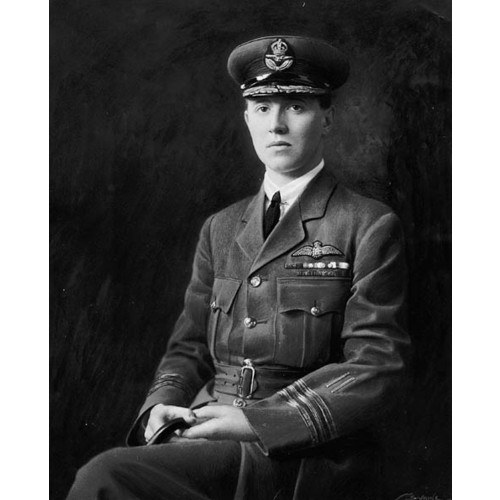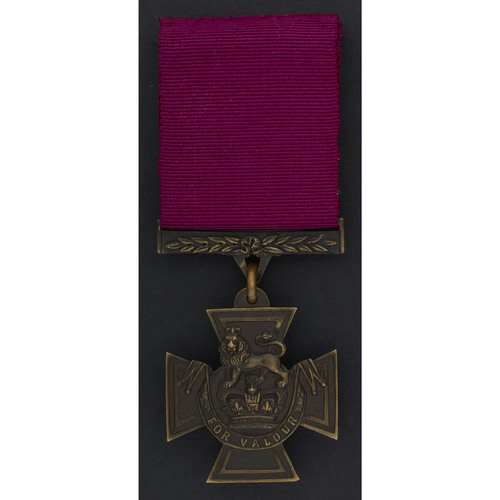BARKER, WILLIAM GEORGE, soldier, air force officer, and businessman; b. 3 Nov. 1894 in Dauphin, Man., son of George William John Barker, a farmer, and Jane Victoria Alguire; m. 1 June 1921 Jean Kilbourn Smith, and they had one daughter; d. 12 March 1930 in Rockcliffe (Ottawa) and was interred in the Mount Pleasant Mausoleum, Toronto.
The eldest of nine surviving children, William Barker was born in a log house on the family farm and was educated at schools in or near Dauphin and Russell, Man. His sister Edna remembered Willie as a boy with innate poise and self-confidence as well as an intense personality. As a teenager he displayed all the qualities that would later make him an exceptional military pilot. He was a kinaesthetic young man, attracted to risk, yet possessed of an analytical and independent mind. Gifted with exceptional eyesight, he was adept at shooting and was a skilled horseback rider. He served in the militia with the 32nd (Manitoba) Horse in 1913. After the outbreak of World War I, Barker, in his final year of high school at Dauphin Collegiate, volunteered for the Canadian Expeditionary Force, enlisting as a trooper in the 1st Canadian Mounted Rifles Regiment on 1 Dec. 1914. He trained as a machine-gunner and arrived in the United Kingdom in June 1915. About 26 September his regiment entered the Ypres (Ieper) salient in Belgium, where he served until late February 1916.
Weary of trench life, Barker volunteered for the Royal Flying Corps as a gunner; he received four weeks of field training with 9 Squadron. He was commissioned a temporary second lieutenant on 2 April 1916 and then joined 4 Squadron as an observer, undertaking artillery cooperation and photographic and visual reconnaissance for ground troops. In July he was transferred to 15 Squadron. Four months later he and his pilot received the Military Cross for their superior work in support of an assault on Beaumont-Hamel (Beaumont), France. In December he was sent to England for pilot training.
Barker completed all flying and ground school training in the brief period of four weeks, was graded a flying officer on 14 Feb. 1917, and returned to 15 Squadron. By the end of May he had been promoted captain and given command of C Flight, and had received a bar to his Military Cross. Wounded by artillery fire in August, he was sent to England for a rest as an instructor.
With no enthusiasm for teaching novices, Barker frequently disobeyed regulations and on at least one occasion performed a low-level aerobatic display over Piccadilly Circus in London. He was transferred to 28 Squadron on 29 September and flew to France on 10 October. By the end of October he had logged at least 35 hours in combat in his Sopwith Camel, B6313, and was credited with destroying three enemy aircraft.
Barker’s squadron was one of several units transferred to northern Italy in late October. On Christmas Day he and Lieutenant Harold Byrne Hudson completed an impromptu low-level attack against a German aerodrome, probably at San Fior, setting fire to one hangar and damaging four aircraft. In January 1918 he and Hudson were reprimanded by the commanding officer of 14 Wing for their successful but unauthorized attacks against enemy kite balloons. As a result of, or perhaps despite, his unauthorized patrols, Barker was awarded the Distinguished Service Order; the citation noted that “his splendid example of fearlessness and magnificent leadership have been of inestimable value to his squadron.” In March he received a second bar to his Military Cross “for conspicuous gallantry and devotion to duty.”
By the time he joined 66 Squadron on 10 April, Barker had 22 victories. As commander of its C Flight, he would be credited with another 16. In May 1918 Barker received the French Croix de Guerre. He was promoted temporary major in July and given command of 139 Squadron, equipped with two-seat Bristol Fighters. Unhappy with this aircraft, he was allowed to keep B6313 and added 8 more victories, bringing his total to 46, a unique achievement by one pilot with one machine. British historians would call B6313 “the single most successful fighter aircraft” in the history of the Royal Air Force.
On the night of 9–10 August, Barker and Captain William Wedgwood Benn dropped an Italian army agent by parachute behind enemy lines. For this flight Barker received the Silver Medal for Military Valour, one of Italy’s highest military decorations. That same month he was awarded a bar to his DSO. Remarkably, in over 12 months of scout operations, from 9 or 10 Oct. 1917 to 27 Oct. 1918, he had never had a wingman killed in action and no aircraft he escorted had been shot down.
Prior to taking up a new command in late October, Barker was permitted to fly anywhere in France for a ten-day roving commission. He selected a Sopwith Snipe, E8102, and attached himself to 201 Squadron. On 27 October he attacked and shot down a German two-seater at around 22,000 feet and, in turn, was attacked by about 15 Fokker D-VIIs. He was wounded three times, but also shot down three more enemy aircraft. Bleeding profusely and barely conscious, he managed to crash-land and was evacuated to a field hospital. Awarded the Victoria Cross on 30 Nov. 1918, Barker now had 50 victories to his credit. Italy later conferred a second Silver Medal on him. While he struggled for survival in a French hospital, the Canadian Daily Record (London, England) declared that he held “the record among Canadians for fighting decorations won during the war.”
Barker’s wounds would cause him considerable physical and emotional pain for the remainder of his life. His legs were damaged and his left elbow was destroyed, effectively turning him into a one-armed pilot. While recovering in London, he met fellow VC recipient William Avery Bishop*. After the end of the war and Barker’s release from hospital in April 1919, the two men first founded Bishop-Barker Company Limited in Ontario and then, in November 1919, a Toronto-based air charter and aircraft maintenance and sales firm, Bishop-Barker Aeroplanes Limited. Around this period they established an American importing firm, Interallied Aircraft Corporation, in New York City.
Barker tackled civil aviation with the same intensity he had shown in combat. Between 23 Aug. and 6 Sept. 1919 he led an aerial display team at the Canadian National Exhibition in Toronto, the first occasion on which formation flying was performed in Canada for a non-military audience. On 25–27 August he participated in an air race from Toronto to New York and back, becoming the first Canadian pilot to carry international airmail. He flew the first commercial cargo between the United States and Canada, from New York City via Montreal to Toronto in January 1921.
A commercial failure, like many other flying companies of this period, Bishop-Barker Aeroplanes ceased flying operations in 1922. On 3 June Barker was commissioned a wing commander in the Canadian Air Force, which had been created two years earlier [see Sir Willoughby Garnons Gwatkin]. His first permanent posting was as the commanding officer of the air station at Camp Borden, where he served from 1 Nov. 1922 to 15 Jan. 1924. He would be remembered for his highly innovative ideas and experiments in aircraft armament. He was then transferred to Ottawa and in mid February assumed the highest position within the CAF, acting director. He held this post on 1 April 1924, when the CAF was disbanded and the Royal Canadian Air Force was officially born [see Sir James Howden MacBrien*]. The following month he was posted to England as the RCAF’s representative to the British Air Ministry. As a liaison officer, Barker witnessed RAF operations in Iraq in the spring of 1925 and in May he began advanced studies at the Royal Air Force Staff College in Andover; he graduated in March 1926.
Barker returned to Canada knowing that he would have to serve under Group Captain James Stanley Scott, the director of the RCAF and an officer he did not respect. Unwilling to compromise, he submitted his resignation in August 1926. He had struggled with the usual adjustments to civilian life of any wounded veteran and especially with the burden of being a much decorated hero. In these last years of his life he also suffered from alcoholism and possibly from post-traumatic stress disorder.
In 1927 the Toronto Maple Leafs’ manager, Constantine Falkland Cary (Conn) Smythe*, a former RAF pilot, had Barker appointed the first president of the hockey club, a symbolic gesture to help raise the losing team’s profile. Smythe, a teetotaller, had no appreciation of the emotional challenges Barker faced and no sympathy for alcohol abuse; this situation led to public embarrassment for both men. Barker was also appointed general manager of an Ontario tobacco-growing company owned by his wife’s father, Horace Bruce Smith. Oddly, Barker was a non-smoker with an antipathy to farming. As a sinecure offered by an unsympathetic father-in-law, the tobacco job was unrewarding, if not humiliating.
A much better post, suited to Barker’s natural talents and experience, was secured when Fairchild Aircraft Limited of Canada in Montreal hired him in January 1930 as vice-president and general manager. While demonstrating a new biplane trainer, the Fairchild KR-21, at the RCAF air station in Rockcliffe, he lost control of the aircraft at the apex of a steep climb and was instantly killed when the aircraft struck the ice on the Ottawa River. His state funeral, held in Toronto on 15 March, included political and military leaders, six VC recipients, and an honour guard of 2,000 men.
On 6 June 1931 an airport in Toronto was renamed Barker Field in his memory and Bishop lauded his friend both then and later as “the deadliest air fighter that ever lived.” Author Ernest Hemingway had another point of view. In a short story published in 1936, “The snows of Kilimanjaro,” he portrayed Barker as a “bloody murderous bastard.” Barker’s character was in keeping with the tradition of the larger-than-life hero. He was driven above all else to excel – to be a figurehead was anathema to him. Because of his untimely death many of his war and post-war achievements would later be overlooked and he would be overshadowed by Bishop, who lived to 1956. The RCAF picked Barker as one of its role models for the recruitment of a new generation of flyers during World War II, but afterwards his legend, well known in Great Britain and the United States, faded in Canada. Few Canadians are aware that he was, and still is, Canada’s most decorated war hero.
[This biography is based on the author’s book Barker VC: William Barker, Canada’s most decorated war hero (London and Toronto, 1997), which contains an exhaustive list of the documentation consulted: military files in the archives of Great Britain, Canada, and the United States, personal papers, logbooks, monographs, newspaper and magazine articles, as well as interviews with relatives and military personnel. w.r.]§
Cite This Article
Wayne Ralph, “BARKER, WILLIAM GEORGE,” in Dictionary of Canadian Biography, vol. 15, University of Toronto/Université Laval, 2003–, accessed January 12, 2026, https://www.biographi.ca/en/bio/barker_william_george_15E.html.
The citation above shows the format for footnotes and endnotes according to the Chicago manual of style (16th edition). Information to be used in other citation formats:
| Permalink: | https://www.biographi.ca/en/bio/barker_william_george_15E.html |
| Author of Article: | Wayne Ralph |
| Title of Article: | BARKER, WILLIAM GEORGE |
| Publication Name: | Dictionary of Canadian Biography, vol. 15 |
| Publisher: | University of Toronto/Université Laval |
| Year of publication: | 2005 |
| Year of revision: | 2005 |
| Access Date: | January 12, 2026 |










